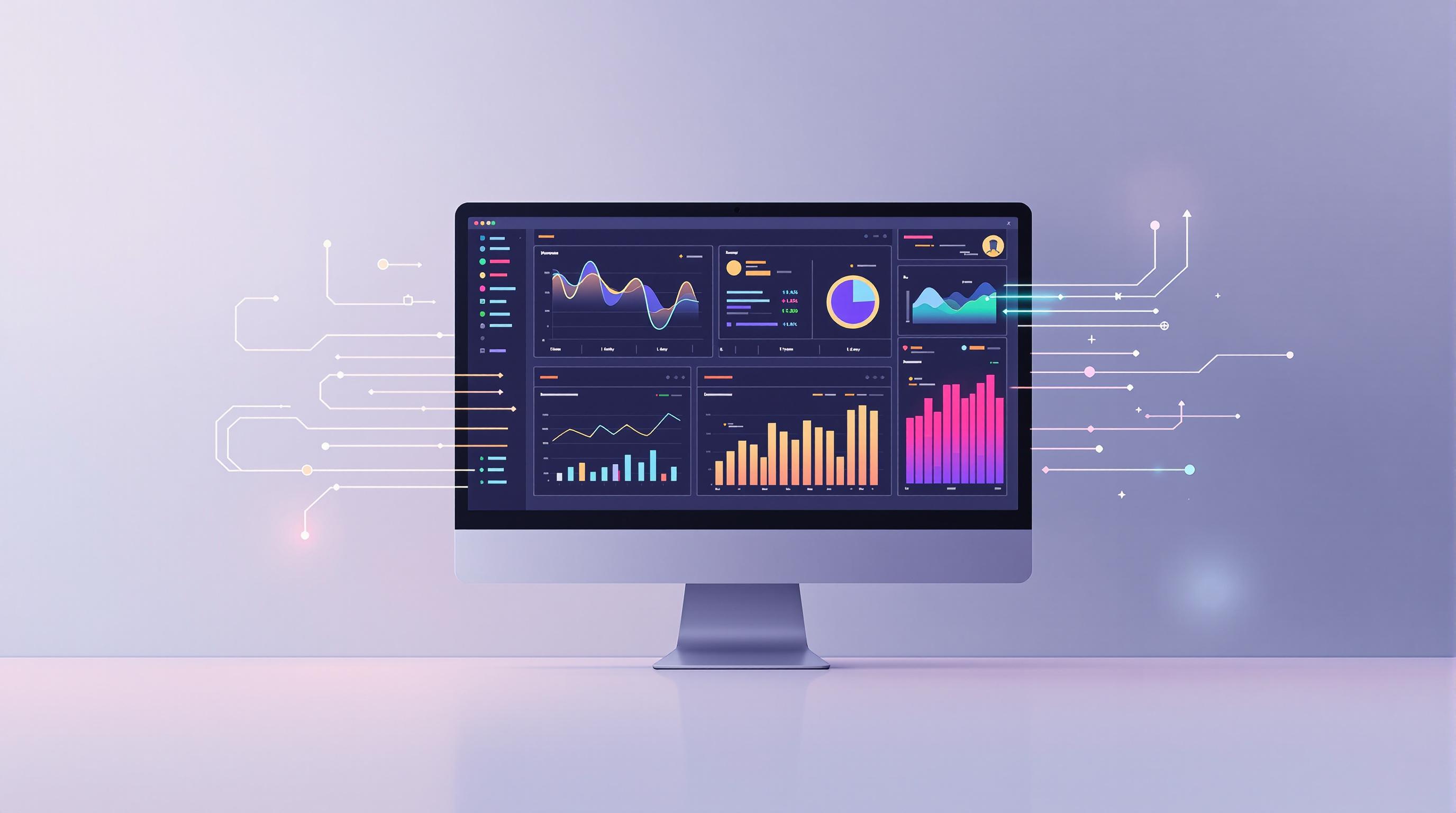AI-powered Application Performance Monitoring (APM) is revolutionizing how we optimize app performance. By leveraging AI and machine learning, these tools can:
- Detect issues and root causes faster by analyzing data from various sources
- Predict performance trends to enable proactive issue prevention
- Automate performance tuning by adjusting settings like cache configurations in real-time
- Improve user experiences by resolving issues faster and preventing downtime
- Increase efficiency and reduce costs through automated monitoring and analysis
Related video from YouTube
Key Features of AI-Powered APM Tools
| Feature | Description |
|---|---|
| Root Cause Analysis | Identify the root cause of performance issues quickly |
| Predict Performance | Forecast future performance trends for proactive measures |
| Automatic Tuning | Optimize performance settings automatically without human intervention |
| Integration | Seamless integration with other monitoring tools for a comprehensive view |
As applications become increasingly complex, AI-powered APM is no longer a luxury but a necessity. Explore and evaluate AI-powered APM tools that meet your specific requirements to ensure your applications consistently perform at their best, providing a seamless user experience and driving business success.
AI-Powered APM Tools Overview
AI-powered Application Performance Monitoring (APM) tools use Artificial Intelligence (AI) and Machine Learning (ML) to monitor and improve app performance. These tools provide real-time insights, detect issues automatically, and predict performance trends. The market offers various AI-powered APM tools for different needs.
Types of AI-Powered APM Tools
AI-powered APM tools can be categorized based on their features, pricing, and target audience:
- Enterprise tools: For large enterprises, with advanced features, scalability, and customization. Examples: AppDynamics, New Relic, Dynatrace.
- SMB tools: For small to medium businesses, more affordable and simplified. Examples: Datadog, Splunk, Sumo Logic.
- Open-source tools: Cost-effective, community-driven. Examples: Prometheus, Grafana, OpenTelemetry.
- Cloud-native tools: For cloud-based apps, integrated with cloud providers like AWS, Azure, and Google Cloud. Examples: AWS X-Ray, Azure Monitor, Google Cloud Trace.
Key Features
AI-powered APM tools offer features that set them apart from traditional APM solutions:
| Feature | Description |
|---|---|
| Predictive analytics | Predict performance trends for proactive issue identification and resolution. |
| Automated issue detection | AI algorithms automatically detect issues, reducing mean time to detection and resolution. |
| Real-time insights | Provide real-time insights into app performance for swift decision-making. |
| Integration | Seamless integration with other monitoring tools for a comprehensive view of app performance. |
In the next section, we will explore these key features and their benefits in more detail.
Key Features of AI-Powered APM
AI-powered Application Performance Monitoring (APM) tools offer features that help improve app performance and user experience. Here are some key features:
Detecting Issues and Root Causes
AI algorithms analyze data from various sources like logs, metrics, and traces to identify patterns and relationships. This helps pinpoint the root cause of performance issues quickly.
| Example |
|---|
| An AI-powered APM tool can analyze log data to find a slow database query causing performance issues. It can then correlate this with CPU and memory usage data to identify the root cause. |
Predicting Performance Trends
These tools use historical data to predict future performance issues and trends. By analyzing patterns, they can identify potential issues before they occur, allowing businesses to take proactive measures.
| Example |
|---|
| An AI-powered APM tool can analyze data from previous days or weeks to predict when a server is likely to become overloaded, enabling businesses to prevent downtime. |
Automated Performance Tuning
AI-powered APM tools can automatically optimize performance in real-time without human intervention. They analyze data and make adjustments to settings like cache configurations.
| Example |
|---|
| An AI-powered APM tool can analyze data from a web application and automatically adjust the cache settings to improve performance. |
Integrating with Other Monitoring Tools
These tools can integrate with other monitoring tools and data sources to provide a unified view of performance. This helps businesses gain a comprehensive understanding of their application's performance.
| Example |
|---|
| An AI-powered APM tool can integrate with a log analysis tool to provide a complete view of application performance and identify areas for improvement. |
Visualizing and Reporting Performance
AI-powered APM tools provide clear insights through advanced visualization and reporting. They can create custom dashboards and reports, enabling businesses to understand their application's performance and identify areas for improvement.
| Example |
|---|
| An AI-powered APM tool can create a custom dashboard that displays key performance metrics like response time and error rate, helping businesses quickly identify areas for improvement. |
Benefits of AI-Powered APM
AI-powered Application Performance Monitoring (APM) tools offer several advantages that can significantly improve app performance, user experience, and operational efficiency:
Better App Performance and User Satisfaction
AI-driven insights help identify and resolve performance issues quickly, leading to:
- Faster response times
- Fewer errors
- Seamless user experience
By analyzing vast data, AI-powered APM tools detect anomalies, predict trends, and provide recommendations to optimize performance.
Faster Issue Detection and Resolution
AI-powered APM tools speed up issue detection and resolution, minimizing downtime and reducing mean time to resolve (MTTR) issues. By automating monitoring and analysis, these tools identify issues in real-time, allowing prompt action.
Proactive Issue Prevention
AI algorithms can predict when an issue is likely to occur, enabling businesses to take preventive measures before users are impacted. This proactive approach ensures applications run optimally, reducing the risk of performance issues and downtime.
| Benefit | Description |
|---|---|
| Improved Performance | AI-driven insights help identify and resolve performance issues quickly. |
| Faster Issue Resolution | Automated monitoring and analysis speed up issue detection and resolution. |
| Proactive Prevention | AI algorithms predict potential issues, allowing proactive measures. |
Increased Efficiency and Cost Savings
AI-powered APM tools automate monitoring and analysis, reducing manual effort and resources required to manage performance. This leads to:
- Increased operational efficiency
- Cost savings
- Ability to focus on strategic initiatives
Scalability for Business Needs
As applications grow and evolve, AI-powered APM tools can handle increased complexity, providing a flexible and scalable solution to manage performance. This ensures businesses can continue delivering high-performance applications as their infrastructure and user base grow.
sbb-itb-9890dba
Challenges and Limitations
Data Quality and Availability
AI models need large amounts of high-quality data to learn and make accurate predictions. Collecting and processing this data can be difficult, especially in complex systems. Ensuring data quality, completeness, and relevance is crucial to avoid incorrect results.
Explaining AI Decisions
As AI models become more complex, it's harder to understand the reasoning behind their predictions. This lack of transparency can lead to mistrust and difficulty identifying errors. Techniques for explaining AI decisions, such as model interpretability and explainability, are essential to build trust and ensure accountability.
Integrating with Existing Systems
Integrating AI-powered APM tools with existing systems and processes can be challenging. These tools may require significant changes to infrastructure, workflows, and personnel. Ensuring seamless integration and minimal disruption to existing operations is crucial for successful adoption.
Security and Privacy
AI-powered APM tools raise security and privacy concerns. As AI models process vast amounts of data, they may be vulnerable to cyber threats and data breaches. Ensuring the security and integrity of these tools is essential to protect sensitive data and prevent unauthorized access.
Skilled Workforce
AI-powered APM tools require a skilled workforce to implement, manage, and maintain them effectively. Ensuring personnel have the necessary skills and training to work with these tools is crucial to realize their full potential.
Challenges at a Glance
| Challenge | Description |
|---|---|
| Data Quality and Availability | Ensuring high-quality, complete, and relevant data for AI models. |
| Explaining AI Decisions | Understanding the reasoning behind AI predictions for transparency and accountability. |
| Integrating with Existing Systems | Seamlessly integrating AI-powered APM tools with existing infrastructure and workflows. |
| Security and Privacy | Protecting sensitive data and preventing unauthorized access to AI models. |
| Skilled Workforce | Having personnel with the necessary skills and training to work with AI-powered APM tools. |
Evaluating AI-Powered APM Tools
Choosing the right AI-powered Application Performance Monitoring (APM) tool is crucial. Here's how to evaluate and select the best tool for your needs:
Compare Key Features
| Tool | Root Cause Analysis | Predict Performance | Automatic Tuning | Integrate with Other Tools |
|---|---|---|---|---|
| Tool A | ✅ | ✅ | ❌ | ✅ |
| Tool B | ✅ | ❌ | ✅ | ✅ |
| Tool C | ❌ | ✅ | ✅ | ❌ |
When comparing tools, consider these key features:
- Root Cause Analysis: Can it identify the root cause of performance issues?
- Predict Performance: Does it forecast future performance trends?
- Automatic Tuning: Can it automatically optimize performance settings?
- Integrate with Other Tools: Does it work seamlessly with your existing monitoring tools?
Evaluate Specific Needs
Consider your organization's unique requirements and use cases:
- Application Complexity: For complex architectures with many dependencies, choose a tool that can handle intricate setups.
- Scalability: If you expect high traffic, select a tool that can scale to meet demand.
- Security and Compliance: For strict security needs, pick a tool that meets your standards.
- Customization: If you need custom dashboards and reports, look for flexible customization options.
Best Practices and Recommendations
Simple Implementation Steps
1. Start small
Begin with a limited scope, like a single app or use case. This allows you to gain experience and build confidence with the tool.
2. Set clear goals
Identify the specific performance metrics you want to improve. Set measurable targets for your AI-powered APM tool.
3. Integrate existing tools
Ensure seamless integration with your current monitoring and analytics tools. This maximizes the benefits of AI-powered APM.
4. Provide training
Offer training and support to your teams. This ensures they can effectively use the tool and understand its insights.
Overcoming Common Challenges
| Challenge | Solution |
|---|---|
| Data quality issues | Ensure data is accurate, complete, and relevant for the AI tool. |
| Lack of expertise | Provide training and support for AI and machine learning. |
| Integration complexities | Plan carefully for integration with existing tools and systems. |
| Resistance to change | Communicate the benefits of AI-powered APM to teams and stakeholders. |
Maximizing Benefits
- Monitor performance metrics: Continuously monitor and analyze metrics to identify areas for improvement.
- Automate tasks: Automate routine tasks like data collection and analysis to free up resources.
- Use predictive analytics: Forecast performance trends and take proactive measures to prevent issues.
- Integrate with DevOps: Integrate AI-powered APM with DevOps practices like continuous integration and delivery.
Future Trends and Developments
As AI-powered APM continues to grow, here are some key trends and developments expected in the future:
Improved AI Algorithms
AI algorithms will become more advanced, enabling:
- More accurate predictions
- Automated issue resolution
- Better user experiences
For example, combining machine learning models with APM will allow for precise anomaly detection, reducing false positives and negatives. AI-powered APM will also analyze complex performance data patterns, enabling proactive issue identification and resolution.
Integration with New Technologies
AI-powered APM tools will integrate with emerging technologies like:
- Internet of Things (IoT)
- Blockchain
- Edge computing
This will expand their capabilities and improve application performance. For instance:
- Integrating with IoT devices will enable real-time monitoring and analysis of application performance in IoT environments.
- Integrating with blockchain technology will provide a secure and transparent way to monitor and analyze application performance.
Expanded Predictive Capabilities
AI-powered APM tools will offer enhanced predictive and prescriptive analytics, enabling organizations to:
- Anticipate and prevent performance issues before they occur
- Analyze historical data, user behavior, and environmental factors
- Predict performance trends and provide recommendations for improvement
This will allow organizations to proactively optimize application performance, reducing downtime and improving user experiences.
| Trend | Description |
|---|---|
| Improved AI Algorithms | More accurate predictions, automated issue resolution, and better user experiences. |
| Integration with New Technologies | Integration with IoT, blockchain, and edge computing to expand capabilities and improve performance. |
| Expanded Predictive Capabilities | Anticipate and prevent issues, analyze data, predict trends, and provide recommendations for improvement. |
Conclusion
Key Takeaways
In summary, AI-powered APM is transforming how we optimize application performance. By utilizing AI and machine learning, organizations can:
- Detect issues and root causes faster: AI algorithms analyze data from various sources to pinpoint performance problems and their underlying causes quickly.
- Predict performance trends: These tools use historical data to forecast potential issues before they occur, enabling proactive measures.
- Automate performance tuning: AI-powered APM can automatically adjust settings like cache configurations to optimize performance in real-time.
- Improve user experiences: By resolving issues faster and preventing downtime, these tools enhance the overall user experience.
- Increase efficiency and reduce costs: Automating monitoring and analysis reduces manual effort, leading to operational efficiencies and cost savings.
Explore AI-Powered APM Tools
As applications become more complex, AI-powered APM is no longer a luxury but a necessity. To stay ahead, it's crucial to explore and evaluate AI-powered APM tools that meet your specific requirements. By adopting these tools, you can ensure your applications consistently perform at their best, providing a seamless user experience and driving business success.
| Benefits of AI-Powered APM |
|---|
| Faster issue detection and resolution |
| Proactive issue prevention |
| Automated performance optimization |
| Improved user experiences |
| Increased operational efficiency |
| Cost savings |



